If you’re wondering what to bring on your next day trip, this post has you covered! I’m going over the ten essentials and why you should carry them. I also cover their history, suggest additional items, and offer tips for customizing your pack. Let’s get packing!
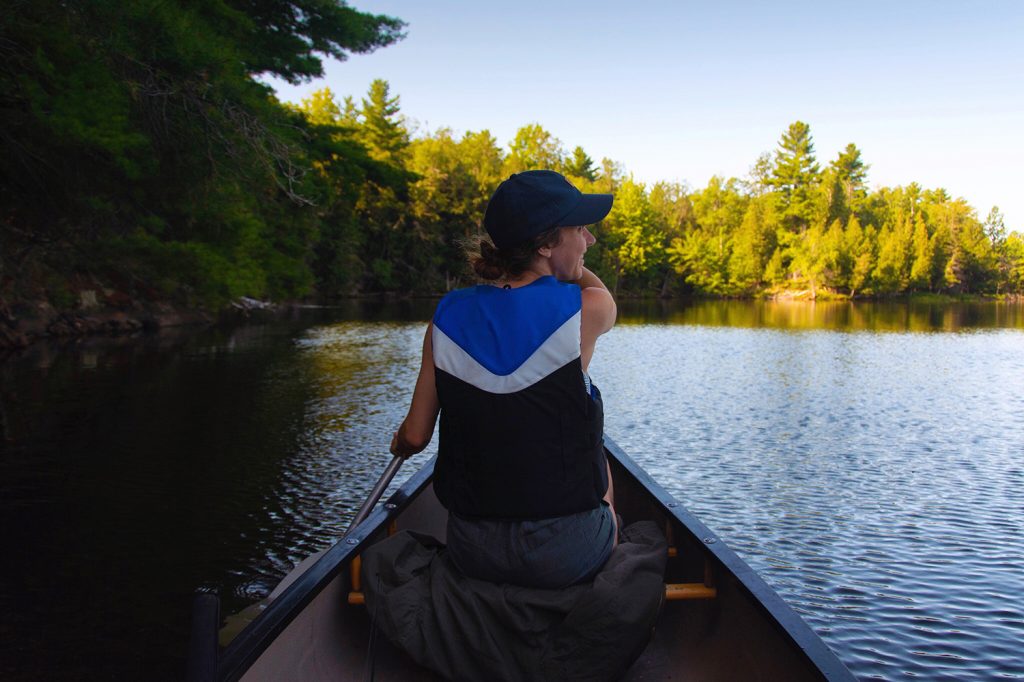
The Ten Essentials
The ten essentials first appeared as a checklist in the third edition of Mountaineering: The Freedom of the Hills, published in 1974. Since then, many organizations have endorsed the ten essentials for promoting wilderness safety, including the British Columbia Search and Rescue Association.
The ten essentials are divided into two categories. The first is to prevent and respond to emergencies and includes navigation and communication devices, a flashlight, sun protection, first aid, and a knife. The second category is equipment to spend a night outside and includes a fire kit, emergency shelter, and extra food, water, and clothes.
It may seem like overkill for a day trip, but emergencies do happen. Many have lost their lives or been seriously injured because they lacked necessary equipment. In some cases, items like an SOS beacon or emergency shelter could have made a life-saving difference.
Let’s go over each item:
Navigation & Communication Devices
If you are travelling to an unmarked or unfamiliar place, you’ll need a topographic map and compass, or global positioning system (GPS). If you can, it’s best to bring all three and know how to use them.
New technologies, like personal location beacons and satellite messengers, allow you to call for help outside of cell service. Beacons send an SOS message with your location tag. Messenger devices are similar and can send text messages. You can purchase devices that combine GPS, SOS, and satellite phone capabilities in a single unit.
Tips:
- Some outdoor clubs, orienteering groups, and outdoor outfitters offer free classes on map and compass skills.
- If your map isn’t waterproof, seal it in a watertight bag. You can buy map cases or use a large Ziploc storage bag.
- Cell phones can act as GPS systems, but you must have access to cell service. If you’re relying on your phone, bring a portable charger.
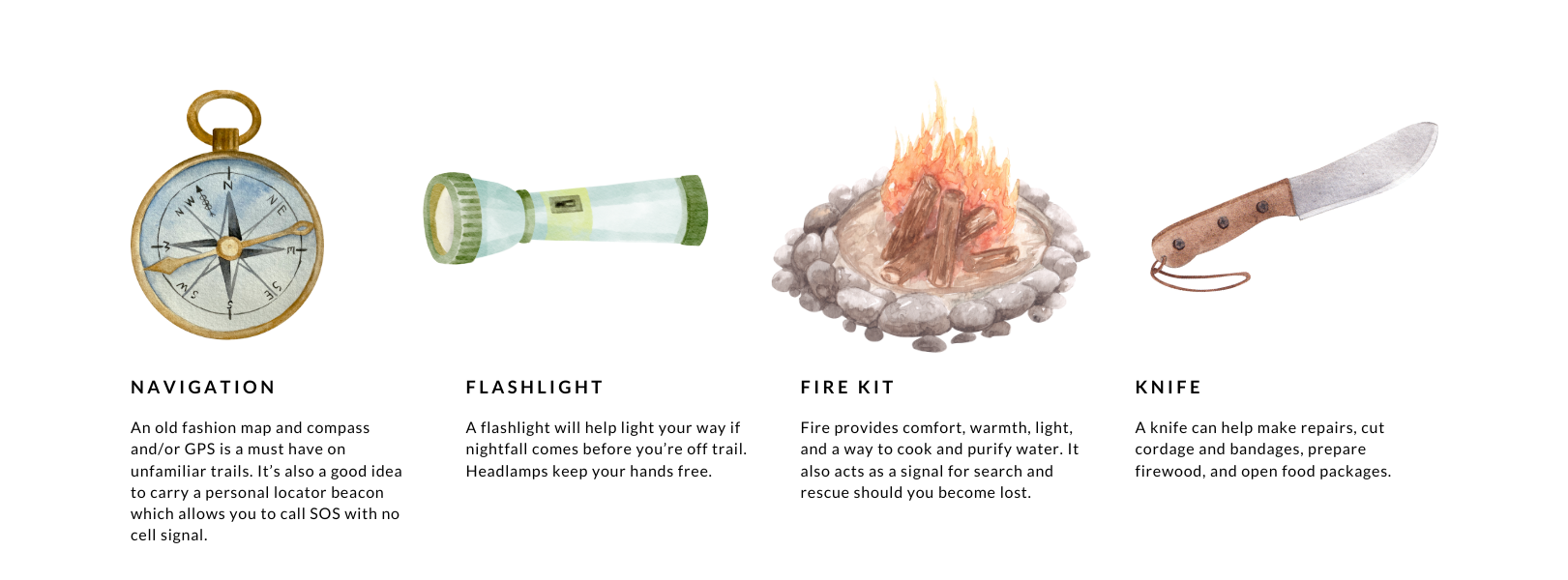
Flashlight
Many years ago, I was hiking with friends, we took a wrong turn, and daylight slipped away. None of us had a light source. Luckily, we were near the trailhead and fumbled our way out. It was a scary reminder of how quickly things can go wrong. Learn from my experience—always pack a light source! Headlamps are best because they free up your hands. Choose one that is bright, fits comfortably on your head, and is waterproof.
Tips:
- Headlamps with flash or strobe capabilities can work as signalling devices at night.
- A light with 200+ lumens is enough to hike at night, set up a tent, and read a map.
- Carry some spare batteries in a waterproof container.
Sun Protection
Sun protection is probably the most skipped ten essential, but prolonged exposure can cause severe burns and sickness. Opt for a sunscreen that’s SPF 30 or higher. This will block out 97% of UVB rays. Sunny environments with snow and water give you an extra dose of sun from reflected light.
Don’t forget to protect your eyes, they can burn before you feel pain. A burn to the cornea causes symptoms like headache, blurred vision, and temporary blindness. Look for glasses with a UV rating of 400 or 100% protection.1
Tips:
- You can buy sun-protective clothing. Sun hats and shirts with UPF 50+ will block out 98% of the sun’s rays.
- I’m allergic to sunscreens, even many “scentless” Canadian and American versions. I’ve had luck with Korean and Japanese sunscreens. If this is a problem for you, check them out.
Knife (& Small Repair Kit)
A knife or multi-tool will allow you to cut and repair items. A pocketknife is useful for precision work. A larger knife can be helpful for gathering and processing firewood. On most day trips, I just bring a small multi-tool that has a knife.
Some people include a small repair kit in this category. The authors of Mountaineering suggest bringing tape and cordage. Other items listed include safety pins, a needle and thread, wire, duct tape, cable ties, plastic buckles, and replacement parts for equipment. What you bring, depends on your activity and gear.
Tips:
- Duct tape can bind and repair items. It’s also highly flammable as a firestarter.
- A multi-tool is a versatile option as they usually include a knife, screwdriver, scissors, and pliers.
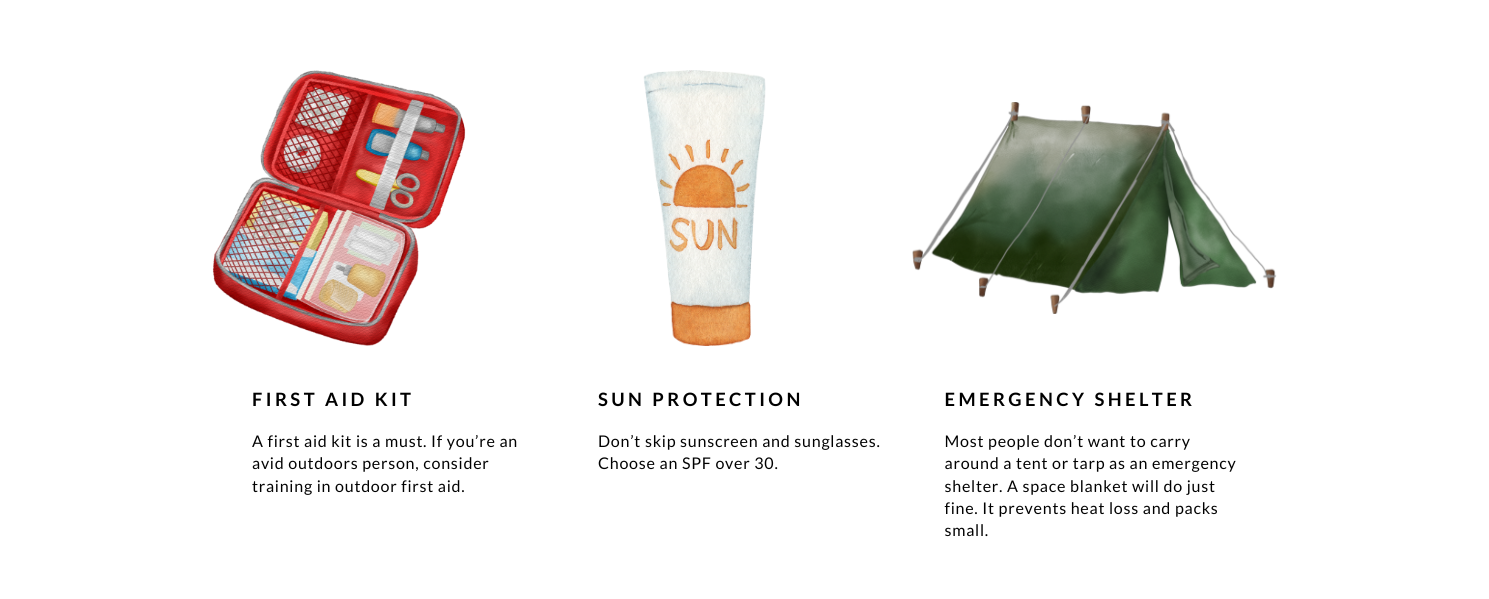
Fire Kit
A fire kit should include a lighter or matches, and some type of firestarter. You can make firestarter by adding petroleum jelly to cotton balls. Kevin Callan wrote an excellent post on homemade firestarters.
Tips:
- Storm-proof matches are water and wind resistant making it easy to start a fire in poor conditions.
- In a pinch, you can use natural materials as tinder. Pine resin, fatwood, and plant downs work well.
First Aid
A first aid kit is an important part of any pack. Minimally, it should contain extra prescription medications, pain killers, antihistamines, bandages, adhesive tape, wound dressing, after bite, moleskin, antiseptic wipes, tweezers, and safety pins.
If you spend lots of time outdoors, enrol in a Wilderness First Aid course. These courses teach you how to respond to common backcountry injuries. In Canada, you can take courses through the Canadian Red Cross, Boreal River Adventures and Canadian Wilderness Medical Training.
Tips:
- Don’t forget to restock your first aid kit after each trip. Check the expiry dates of prescription and over-the-counter medications.
- An unbreakable mirror (made of stainless steel or plastic) can help with self-examination of wounds.
Emergency Shelter
An emergency shelter will help protect you from the elements and provide some peace of mind. You can use a tarp, tube tent, or bivy sack. Many people don’t want to carry these bulky and heavy items. In that case, bring an emergency blanket. They’re made of heat reflective materials that help reduce heat loss.
Tips:
- Emergency blankets have reflective surfaces that can double as a distress signal.
- In an emergency, layered spruce boughs can act as an effective insulator against the cold ground.
Extra Food
Carry an extra day’s worth of calories to keep you nourished if you get lost or delayed. Focus on high calorie snacks like, jerky, protein bars, granola, nuts, chocolate, salami, cheese, and meal powders.
Tips:
- Coffee drinkers can experience bad headaches from withdrawal. If that’s you, pack some instant coffee.
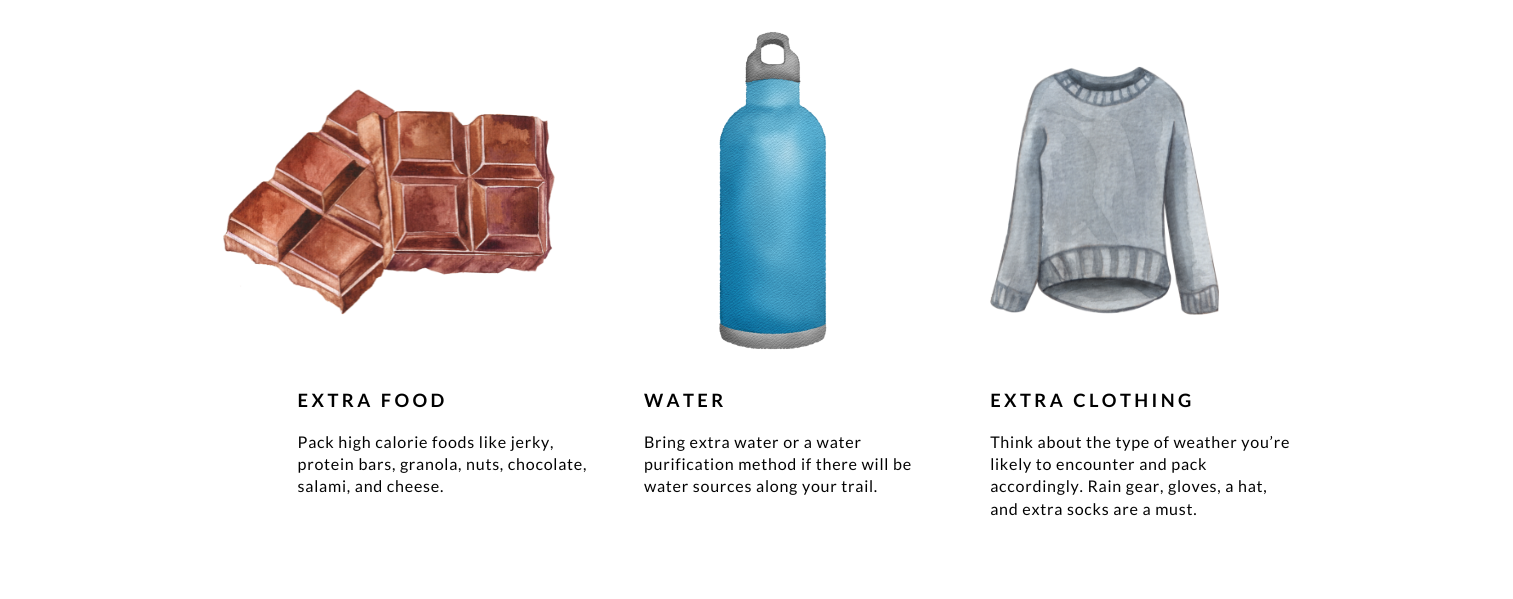
Extra Water
Two litres of water per day is a general guideline, but the more exercise you do, the more you need. Water is heavy – adding 2 pounds per litre! Water bladders and collapsible bottles help reduce weight and bulk. If you’re hiking or adventuring near abundant water sources, save yourself some weight and bring a water filtration system or purification tablets.
Tips:
- Sawyer and other companies make pocket-sized water filtration system.
Extra Clothing
When choosing extra clothing, consider the season and potential weather conditions. You’ll need to bring enough clothes to get through a night. Make sure to include extra base layers and socks.
Tips:
- You can find fleece, polyester, and wool base layers for cheap in thrift stores.
- If you don’t have a rain coat, carry an emergency poncho.
Further Suggestions
Here are a few extra items that I carry in my pack:
Signalling Device
I carry a whistle and a reflective mirror. Three loud blasts on a whistle is the universal signal for distress. Each blast should be around 3 seconds. Take a breath between each blast to allow the sound to travel.
Tips:
- A distress signal can also be done with a mirror. Direct the light at your target and flash the light at them three times.
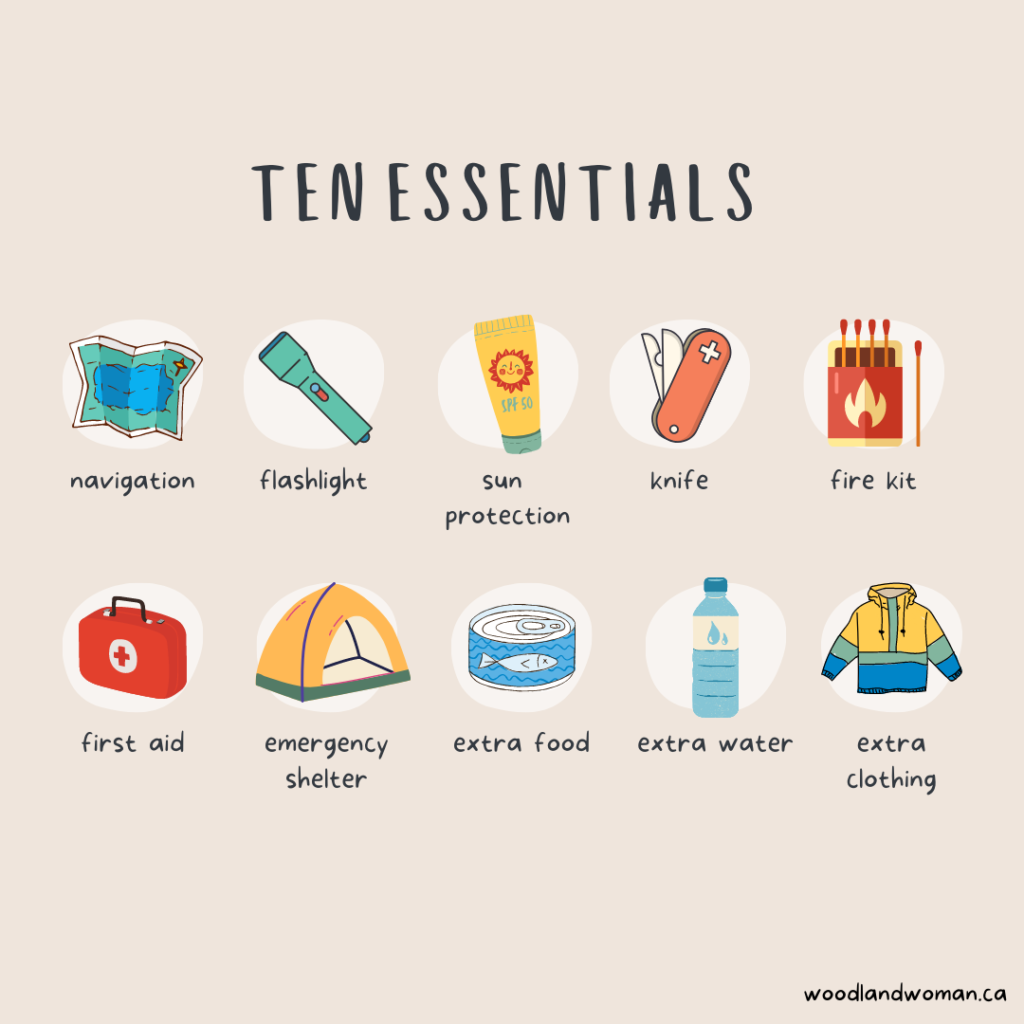
Trip Plan
I tell someone where I’m going every time I venture into the woods. Trip plans say where you are going, who you are going with, when you’ll be back, what you are doing, and what equipment you are using. This information is vital if search and rescue is ever needed.
Tips:
- I’ve written an entire post about trip plans here.
- Adventure Smart has a free app that guides you through making a trip plan. You can then email or text your plan to someone.
Insect and Tick Repellent
If you live in a place with biting insects, you’ll need bug spray. I wrote a whole post about what works and doesn’t work. To summarize:
Picaridin and lemon eucalyptus are proven to help repel and protect against mosquitoes, ticks, and black flies. You can use them on skin and clothing.
DEET works well on mosquitoes and ticks, but it’s not effective against black flies. You can use it on skin and clothing. DO NOT use DEET on plastics or synthetic materials. It will start to dissolve them. There are so many horror stories about DEET destroying expensive weather sealed clothing and GPS devices.
Permethrin is effective against mosquitoes, ticks, and black flies. You can use it on clothing, but it’s unsafe on skin. Some outdoor gear is pretreated with permethrin. It should be good for several washes before you have to reapply the chemical. Unfortunately, permethrin spray is not available in Canada.
Tips:
- Contrary to popular belief, citronella is not an effective insect repellent.
- You should never use essential oils (peppermint oil, etc.) to remove ticks, this can cause them to regurgitate and increases the risk of disease transmission.
Putting Together Your Day Pack
Now that you know the ten essentials, you’re ready to put together your day bag. Pack as light as possible without sacrificing your safety. Carrying too much weight can be dangerous. It makes travelling difficult and tires you faster. Worst case scenario, you can hurt yourself.
Over time, you’ll find the right balance between weight and comfort. Never ditch the essentials. Instead, think about how you can make your gear as light as possible. After each trip ask yourself: Was my pack too heavy? Did I need more water or food? Was there something I forgot to bring? Adjust accordingly.
Store your ten essentials together in a place that is easy to access. That way, you can grab them and go. If you don’t have to repack or search for things, it’s more likely that you’ll bring them.
Other Posts You May Enjoy
The Ultimate Fall Camping Guide
Solo Hiking: Overcoming Fear and Embracing Adventure
Sources
Mountaineering is now in its 9th edition. It goes into greater depth on the ten essentials and surviving in the outdoors. I highly recommend it.
Truc Nguyen. 2021. “Are the Sunglasses You’re Wearing Safe? Here’s What to Look Out For.” CBC.